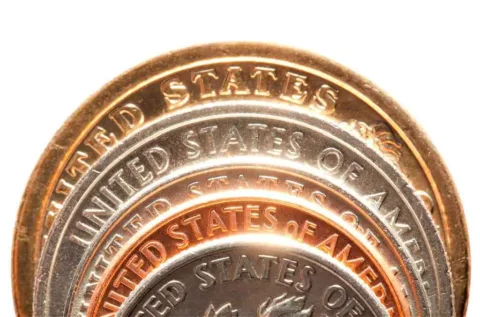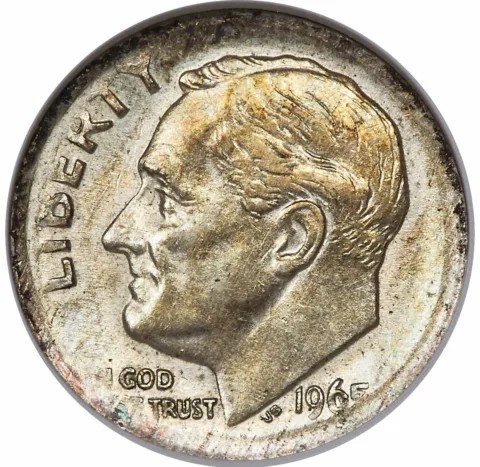
Did you know that some 1965 coins are worth money? …A lot of money!
Some 1965 coin values go into the hundreds — and even thousands — of dollars.
But you’ve got to know which 1965 coins to look for.
Read on to find out how to tell the rare and valuable coins from 1965 apart from the ones you can safely spend for their face value.
Why Are Some 1965 Coins Valuable?
Let’s be clear about one thing first…
Since I don’t want to build any false hopes on what your 1965 coins may be worth, it’s important to know up front that most circulated coins from 1965 are worth only face value — or just a bit above, depending on which coin we’re talking about. That’s because of all of the wear and tear these coins have experienced while being spent as money, inside vending machines and such throughout the years.
But I also want you to know that, indeed, there really are some rare 1965 coins that are worth a lot of money!
These coins are rare. Period. There’s no guarantee you will find them. But you can bet your bottom dollar they’re worth looking for. And they can be fun to look for, too — especially if you enjoy searching through coin rolls and spare change jars.
So, with that, let’s get to the point here… Why are some 1965 coins valuable?
#1 – First, coins of almost any date and denomination can be worth a significant amount of money if they’re in pristine condition — the very top grades of Mint State (or uncirculated). Coins in great condition are not the type of coins you’re likely to find in your spare change, but you might find them while searching through rolls of coins from the bank and jars of old coins that have been saved through the years.
Here’s how to tell the grade of your coin. (And coin grading apps are also a big help!)
#2 – Another thing that can make 1965 coins valuable? Errors. By errors, I mean U.S. Mint mistakes. You see, most of the unusual-looking things you’ll find on the coins you pull from circulation are actually not errors but rather post-mint damage — stuff like rim dents, holes, misshapen letters (shifted by wear or dislodging of surrounding metal), and the like. Legit error coins are the result of mistakes that occurred while the coin was being made at a U.S. Mint facility — those are worth money!
These are the types of coin errors and varieties that are legit U.S. Mint-made mistakes worth the big bucks!
#3 – Finally, there is bullion value. The bullion value of a coin is determined by its weight, its fineness (proportion of precious metal to total weight), and the current price of the metal.
With regard to 1965 coins, specifically:
- The 1965 half dollar contains a 40% silver composition, and therefore this coin is worth more than face value (as we’ll explore below).
- The rising price of copper has also led 1965 pennies to be worth a little more than their face value of one cent (which we will also address below).
- The 1965 nickel — which was made with a 75% copper and 25% nickel composition — is also saved by many collectors due to the rising bullion values of both copper and nickel.
- However, 1965 dimes and quarters — which were made with a copper-nickel clad composition — don’t contain enough valuable metal at this point to be worth more as bullion. Therefore, most are only worth face value.
What’s The Big Deal About Coins From 1965?
There’s a lot of buzz about the coins from 1965 — and that year in general — among collectors of United States coinage.
Why? Because a lot of big changes were happening with U.S. coins and the United States Mint in 1965.
Perhaps the biggest, and certainly most lasting, of these changes was the end of 90% silver circulating dimes, quarters, and half dollars — the last of which were dated 1964.
The Coinage Act of 1965, signed into law by President Lyndon B. Johnson on July 23 of that year, required the dime and quarter to be made from a copper-nickel clad composition and the half dollar to be converted into a 40% silver format — all in the face of rising silver prices. (Today, all circulating dimes and quarters are made from clad. So, too, is the half dollar — which saw its first year as a copper-nickel coin in 1971.)
Furthermore, an ongoing major coin shortage promoted the U.S. Mint to temporarily remove mintmarks from all coins beginning in 1965 — a move that was supposed to dissuade collectors from removing coins from circulation based on the presence (or lack of) a mintmark. This initiative lasted through 1967.
Finally, the U.S. Mint halted production of traditional mint sets and proof sets in favor of a single product called a special mint set (SMS) — which contains one example of each denomination donning a higher-quality finish than ordinary mint-state coins. The special mint sets were in production from 1965 through 1967.
Most Valuable Coins From The Year 1965
Okay, now let’s talk about the most valuable coins from 1965…
1965 Penny Value
Due to their copper composition, all 1965 pennies are worth at least 2 to 3 cents — even in worn condition. Uncirculated specimens are worth 10 to 30 cents each, while a typical 1965 SMS penny sells for 50 cents to $1. The most valuable 1965 penny sold for $690.
1965 Nickel Value
The 1965 nickel is a common coin, though some people like holding them aside because these coins are getting older and more difficult to find in pocket change. Generally speaking, circulated 1965 nickels are worth face value — though they can be worth double or triple their face value when nickel prices spike a bit. Uncirculated 1965 nickels are worth 50 cents to $1, while a 1965 SMS nickel can fetch $1 to $2. The most valuable 1965 nickel sold for $6,325.
1965 Dime Value

If you find a 1965 dime in your pocket change, it’s most likely worth face value of just 10 cents. Uncirculated examples are worth 75 cents to $1.50 on average, and 1965 SMS dimes sell for $1 to $3.
However… a few 1965 silver dimes were accidentally produced on the 90% silver planchets intended for 1964-dated dimes!
What are the two tell-tale signs of a rare 1965 silver dime error?
- The lack of an orange or brown strip along the edge (the copper band seen on clad coins)
- The weight — a silver dime registers at around 2.5 grams, while a clad dime typically weighs just 2.27 grams
The 1965 silver dime values range from $3,800 to more than $16,000, depending on the coin’s condition.
Don’t have a coin scale yet? These are the best scales for weighing U.S. coins. (Another helpful tool for inspecting your coins more closely is a coin magnifier.)
1965 Quarter Value
Most worn 1965 quarters are worth just 25 cents, with uncirculated specimens fetching $1 to $3, and 1965 SMS quarters taking $2 to $4.
But there’s a reason to keep a close eye on each 1965 quarter that passes through your hands. There is a rare and valuable 1965 silver quarter error that’s worth a lot of money!
Here’s what to look for:
- A 1965 silver quarter does not have the orange or brown copper band like clad quarters have
- The silver quarter weighs 6.25 grams, while the clad quarter comes in at 5.67 grams
If you find a 1965 silver quarter error, you’ve landed a coin worth thousands of dollars. Most 1965 silver quarter error values range from $7,000 to more than $10,000!
1965 Half Dollar Value
The 1965 half dollar is a valuable coin no matter what condition it’s in. Since this coin has a 40% silver composition, silver prices dictate its value well above 50 cents. When silver prices are $20 an ounce, a 1965 half dollar contains about $3 in silver. The most valuable 1965 half dollar took $12,650 at auction.




